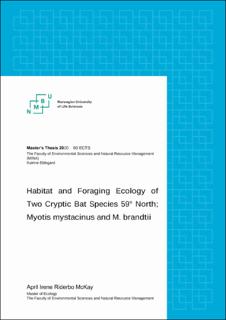| dc.contributor.advisor | Eldegard, Katrine | |
| dc.contributor.advisor | Kooij, Jeroen van der | |
| dc.contributor.author | McKay, April Irene Riderbo | |
| dc.coverage.spatial | Norway | en_US |
| dc.date.accessioned | 2020-10-15T08:35:36Z | |
| dc.date.available | 2020-10-15T08:35:36Z | |
| dc.date.issued | 2020 | |
| dc.identifier.uri | https://hdl.handle.net/11250/2682968 | |
| dc.description.abstract | The Brandts’ bat (Myotis brandtii) and the whiskered bat (Myotis mystacinus) are cryptic species from distinct taxonomic clades whose ranges frequently overlap. What, if any, resource partitioning that exists between them is not well understood, especially at the northern extent of their range. The aim of this study is to compare the foraging ecology, roost ecology and diet of M. brandtii and M. mystacinus during the summer in southeastern Norway.
Bats were captured using mist nets and adult females were radio-tagged. Tagged individuals were tracked for a week on average, during which time the entire period of foraging every night and roost activity were monitored. LiDAR (light detection and ranging) data describing habitat structure in observed foraging locations, and an equal number of random locations within each bat’s home range, were used to build resource selection functions (RSFs) to evaluate differences in foraging habitat use between the two species. Feces from captured bats were analyzed using molecular genetic analysis to verify in-hand identification of these cryptic species in addition to dietary analyses.
I found that forests with varied canopy height were important foraging locations for both species but that M. mystacinus was predicted to use more diverse vegetation structure than M. brandtii, reinforcing previous research which has proposed that M. brandtii is more specialized to mature forests while M. mystacinus is more generalized in habitat selection. The home range of M. brandtii was over 3 times the size of M. mystacinus, further suggesting that M. brandtii is willing to travel farther distances to reach specific habitat than M. mystacinus that is adapted to using a variety of foraging habitat. Both species utilized similar roosts, with colonies only being found in the roofs of houses.
This is the first study to compare the foraging ecology of M. brandtii and M. mystacinus using 3-dimensional continuous descriptions of habitat. Furthermore, it is one of few studies that has accomplished homing in on radio-tagged bats to collect precise foraging locations. The findings here can provide insights into monitoring techniques that can be applied to studying bats at northern latitudes as well as for studying resource selection of bats globally. | en_US |
| dc.language.iso | eng | en_US |
| dc.publisher | Norwegian University of Life Sciences, Ås | en_US |
| dc.rights | Attribution-NonCommercial-NoDerivatives 4.0 Internasjonal | * |
| dc.rights.uri | http://creativecommons.org/licenses/by-nc-nd/4.0/deed.no | * |
| dc.subject | Whiskered bats | en_US |
| dc.subject | Brandts' bats | en_US |
| dc.subject | Myotis mystacinus | en_US |
| dc.subject | Myotis brandtii | en_US |
| dc.subject | Bats | en_US |
| dc.title | Habitat and foraging ecology of two cryptic bat species 59° North : Myotis mystacinus and M. brandtii | en_US |
| dc.type | Master thesis | en_US |
| dc.source.pagenumber | 84 | en_US |
| dc.description.localcode | M-ECOL | en_US |

